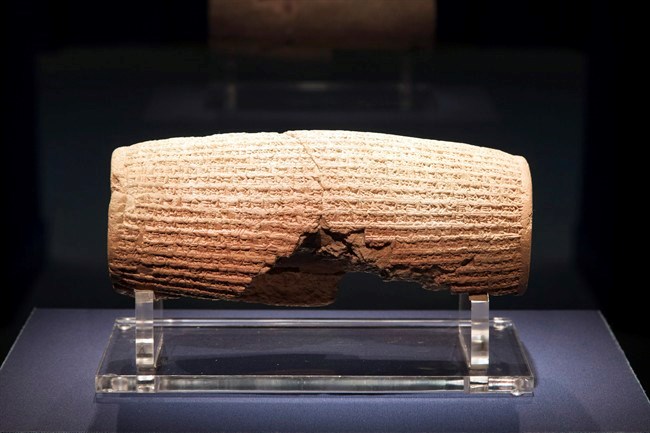WASHINGTON - A nearly 2,600-year-old clay cylinder described as the world's first human rights declaration is being shown for the first time in the United States.
The Cyrus Cylinder from ancient Babylon will be displayed beginning Saturday at the Smithsonian's Sackler Gallery. It will be in Washington through April 28, on loan from the British Museum. A yearlong U.S. tour will follow, with exhibitions planned in Houston, New York, San Francisco and Los Angeles.
The cylinder carries an account, written in cuneiform, of how Persian King Cyrus conquered Babylon in 539 sa国际传媒 and would allow freedom of worship and abolish forced labour. The account also confirms a story from the Bible's Old Testament, describing how Cyrus released people held captive to go back to their homes, including the Jews' return to Jerusalem to build the Temple.
The cylinder was buried under a foundation wall of the city of Babylon. It's long been held as a model of good governance for a vast, multicultural society, and it made Cyrus famous from accounts in the Bible and writings by Greek authors. When the cylinder was discovered on a British expedition in modern-day Iraq in 1879, it was considered the first physical evidence of the biblical account.
"It's the first evidence we have of people reflecting on how you run a society of diversity, without just forcing uniformity," British Museum Director Neil MacGregor said. "The big question is: How can you manage a state that doesn't have one faith?"
The museum pairs the football-size cylinder with other artifacts from Cyrus' era to show how the Persian empire grew to span many religions, languages and cultures, its borders stretching from China to Egypt and the Balkans. It includes seals showing the king's authority, Persian coins, and religious symbols in gold and silver.
Also on view are two pieces of a flat tablet with matching words from the cylinder, showing it was published as a proclamation. The pieces were discovered in the British Museum's collection in 2009.
The cylinder carries ongoing relevance in the world today, Sackler Gallery Director Julian Raby said. "Here is a document that in its time declared a new way of ruling ... in which diversity was respected within a culture," he said.
When the cylinder was shown in 2010 and 2011 in Iran, it drew at least half a million visitors, showing that Iranians are still proud of the artifact as a central piece of their history, curators said. Before the current tour, it had been shown only in Tehran, Barcelona and London.
In the U.S., it's being shown with one of President Thomas Jefferson's copies of "Cyropaedia," a book by Greek historian Xenophon about the philosophies of Cyrus, to illustrate how the Persian king inspired America's founding fathers.
Curator John Curtis said the story of Cyrus also is a reminder of the rich history of the Middle East as a region of diverse cultures that included relations between Israel and Iran.
Though the cylinder is a small object, it raises big political questions, MacGregor said. Both Europeans and Americans looked to the Cyrus model to manage a state with more than one faith.
"Only the Americans get to the Cyrus model of a state that's equidistant from every faith so that you acknowledge the value of faith, but you don't endorse any one variety," MacGregor said. "Of course, we're all trying now to live in cities and countries that have an unprecedented diversity in faith, language, ethnicity ... and this is the first model of someone who got it to work for several hundred years."
___
Cyrus Cylinder: http://cyruscylinder2013.com/
___
Follow Brett Zongker on Twitter at https://twitter.com/DCArtBeat



